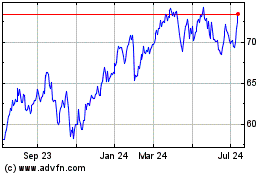MetLife White Paper Provides Tips for Employers for Helping Employees Better Prepare for the Potential Cost of a Serious Illness
November 09 2010 - 10:20AM
Business Wire
MetLife, a leading provider of employee benefits, today
announced the release of a new white paper that examines the
awareness of critical illness insurance (CII) among employees and
the financial impact that a critical illness can have on a typical
U.S. household. Critical Times Require Critical Solutions exposes
the gaps in personal financial safety nets that a health situation
may create despite having medical and disability income coverage
and outlines steps employers can take to help employees obtain the
right amount of protection. To download the white paper, visit
www.metlife.com/business and click on the “Voluntary Benefits”
link.
The research detailed in Critical Times Require Critical
Solutions found that the average financial burden associated with
recovering from a critical illness is $35,500, most of which is
linked to lost income. Few full-time employees – only 16% of those
surveyed -- feel confident they could pay for a medical emergency.
In a challenging economic environment, employees lack the resources
to cope with these unforeseen expenses: About four in ten full-time
employees surveyed indicated that they live paycheck to
paycheck
“When faced with a critical illness, many individuals are
surprised that their medical coverage may not address the full
financial consequences of their sickness. A lump sum benefit
provided by critical illness insurance can help mitigate the spike
in expenses that can result from deductibles, co-insurance,
uncovered expenses and annual benefit maximums,” says Clea Barth,
vice president, Critical Illness Insurance Products, for MetLife.
“However, critical illness insurance doesn’t yet have high
visibility within employee benefit offerings because there’s still
considerable lack of awareness surrounding this product.”
The white paper explains that just 28% of full-time employees
surveyed say they have heard of CII and among those, the majority
are confusing it for health insurance, disability income insurance,
or a government insurance program. However, about 75% of employees
who don’t own critical illness insurance or have never heard of it,
find the concept appealing once the products features are
explained. Most are even willing to pay the entire premium.
Including critical illness insurance as a voluntary offering within
a comprehensive benefit program can be a cost-effective way for
employers to improve employee benefit satisfaction and employee
retention.
For those offering CII, Barth offers the following suggestions
to maximize employee participation in a voluntary critical illness
insurance benefit:
- Promote as supplement – Promote
critical illness insurance alongside other core benefits to
supplement existing medical and disability income benefit plans –
thus, strengthening the financial safety net for employees by
stitching in another layer of protection from out-of- pocket
medical and non-medical expenses.
- Improve communications – For
better communications, employers can correlate an employees’
benefits offering with their individual financial concerns, or
illustrate how financial protection benefits are relevant in
building a strong personal safety net and helping to provide peace
of mind. Strong benefit communications can also help reinforce the
employer’s commitment to their employee’s well-being and strengthen
employee engagement in the benefits program.
- Keep the product simple –
Keeping the product simple is one key way to ensure that the
benefit communications are straightforward and effective. The lump
sum that critical illness insurance offers eliminates the need for
ongoing claims paperwork. There is also flexibility for the
employee. They can use the lump sum payment as they see fit for
both medical and non-medical expenses.
“Employers are increasingly asking employees to take more
responsibility for their financial and medical well-being,” says
Barth. “Offering critical illness insurance can have a positive
impact on employees’ perception of their employer because it helps
fill a potential gap in their financial safety nets. Plus, helping
employees more easily handle financial issues during a critical
illness allows them to focus on their physical recovery and may
help them return to full productivity.”
Research Methodology
In April 2010, MetLife conducted two online surveys to closely
examine the awareness of critical illness insurance and the
financial impact that a critical illness can have on a typical U.S.
household. The first survey, The MetLife Critical Illness Awareness
Study, featured interviews with 1,000 respondents, ages 25 to 55,
including 508 people who work full-time. The second survey, The
Financial Impact of a Critical Illness Study, featured interviews
with 1,002 respondents, ages 25 to 55, who experienced cancer, a
heart attack or stroke either first hand or through a spouse --
between six months and five years prior to the survey. A key
requirement to participate in the study was that the individual for
whom the survey questions were intended had health insurance at the
time of diagnosis.
About MetLife
MetLife is a subsidiary of MetLife, Inc. (NYSE: MET), a leading
global provider of insurance, annuities and employee benefit
programs, serving 90 million customers in over 60 countries.
Through its subsidiaries and affiliates, MetLife holds leading
market positions in the United States, Japan, Latin America, Asia
Pacific, Europe and the Middle East. For more information, visit
www.metlife.com.
MetLife (NYSE:MET)
Historical Stock Chart
From Oct 2024 to Nov 2024

MetLife (NYSE:MET)
Historical Stock Chart
From Nov 2023 to Nov 2024
